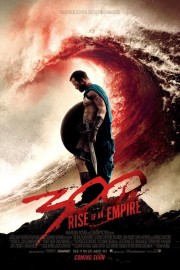300: Rise of an Empire
Reading back over my review of Zack Snyder’s 2007 smash, “300,” I was surprised by how little, relatively speaking, I wrote about it, especially considering how strong of a reaction I had to the film when I saw it. Granted, that reaction was one of strong apathy towards the film’s ultra-stylized visual language and weak characterizations, but it was an immediate and intense reaction nonetheless.
Seven years later, the story of the Greeks battling of the Persian army, led by their towering demigod, Xerses, continues to be told, by way of Frank Miller (whose follow-up graphic novel provides the spine of the story) and Zack Snyder (who is still co-writer, but gives the director’s chair to Noam Murro), in a movie that isn’t so much a prequel, or a sequel, but more of a continuance of the same story, happening concurrently with the events of “300,” where the Spartan army, led by King Leonidas, met the Persian army, and lost. It’s an interesting continuation of the narrative, and it brings slightly more heft to the storytelling, but it’s even flatter as a cinematic experience, probably because the main Greek leader in this film, Themistocles (played by Sullivan Stapleton), who hopes the sacrifice of the Spartans will unite Greece against Xerses’s forces, lacks the intensity and charisma of Gerard Butler’s Leonidas. That becomes clearer every time we see Lena Headey’s Spartan Queen Gorgo on-screen, and hear her voice on the soundtrack as the narrator– yes, the characters in “300” were weakly defined in the script, but even I have to acknowledge that the actors performed the Hell out of them. Queen Gorgo should be the one leading the Greek army (although for narrative reasons, it makes sense that she isn’t), because as he’s presented, I wouldn’t follow Themistocles into a Wal-Mart, let alone a battle.
Having Queen Gorgo lead the army would also have provided an interesting dynamic with Artemisia, the leader of the Persian navy, played by Eva Green. Xerses (still played by Rodrigo Santoro) may be the true leader of the Persian army, but he’s sidelined for a lot of the movie for putting focus on Artemisia, whose family was slaughtered by the Greek army, and now has returned to seek vengeance. She’s a more interesting character anyway, and is played by Eva Green in a volatile, seductive performance that really kicks the film into gear after idling at the start, and not just because of the outrageous sex scene between Artemisia and Themistocles mid-way through. Artemisia is brilliant at battle strategy, and even though the Greeks get a leg up on her at times, it’s not for long, and for much of the movie, it’s very easy to see how the Persians might win the war. That is, until the very end of the movie, where the event I had been hoping for during the previous 90-plus minutes, occurs, and basically proves my point about Themistocles.
The world of “300,” though, still leaves me feeling numb. The tactic of using slow-motion as a way of capturing the panels of a graphic novel (which Snyder, thankfully, got away from for last year’s “Man of Steel”) just doesn’t have the intended effect on me, and just makes the film a dull, drab experience. I do like the over-the-top score by Junkie XL, and the visual design of the “300” world is expertly designed by production designer Patrick Tatopoulos (“Dark City”), but it all comes down to story and character in the end, and aside from the strong characterizations by Green and Headey, that’s where these films lose me. It’s impossible to get lost in a movie when you feel like it’s holding you at arm’s length, and that’s how it continues to feel with these movies.










